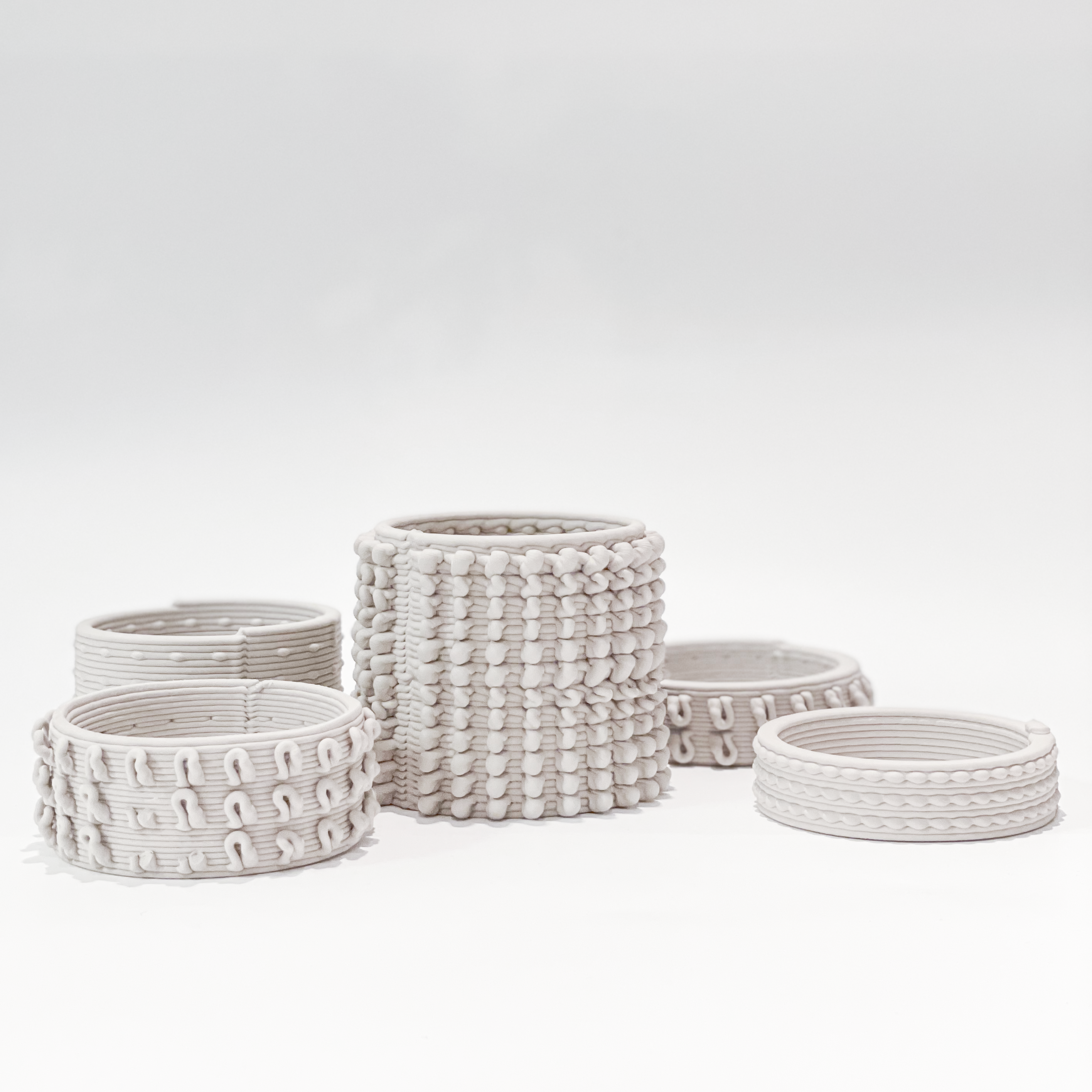Sono-Textures: Exploration in Pattern Legibility in Additive Clay 3D Printing
2022
Harvard University Graduate School of Design
Instructor: Nathan King & Zach Seibold
Team: Danny Clarke (MDes ‘23), Yangsun Lim (M.Arch II ‘24), Saad Boujane (MAUD ‘23), Elsa Mendoza (MDes ‘22).
Special thanks to the Ceramics Program and the Office for the Arts at Harvard for their support.
Instructor: Nathan King & Zach Seibold
Team: Danny Clarke (MDes ‘23), Yangsun Lim (M.Arch II ‘24), Saad Boujane (MAUD ‘23), Elsa Mendoza (MDes ‘22).
Special thanks to the Ceramics Program and the Office for the Arts at Harvard for their support.
The basic concept of Sono-Textures is that frequencies are mapped to toolpath layers from low to high, where lower frequencies begin at the bottom of the print andascend toward higher frequencies at the top of the print. A column of points on the print represents a moment in time in the song beginning at the start of the print. Time is read around the circumference of the clay artifact. The premise of our concept is that for each frequency group, low sounds are represented by small articulations in the clay pattern.
Conversely, louder sounds are represented by larger articulations in the clay pattern. The research seeks to produce printed frequency patterns in clay artifacts which transmit a degree of legibility through a visual correlation of patterns back to the song from which thefrequency data is derived from. This necessitated the development of a digital workflow with a set of system variables for mapping frequencies to toolpaths which did not exist.
Ultimately, Sono-textures attempts to find legibility within the printed patterns and
texture of clay artifacts using frequencies isolated from the audible frequency spectrum of song files to create toolpaths for 3D clay printing.


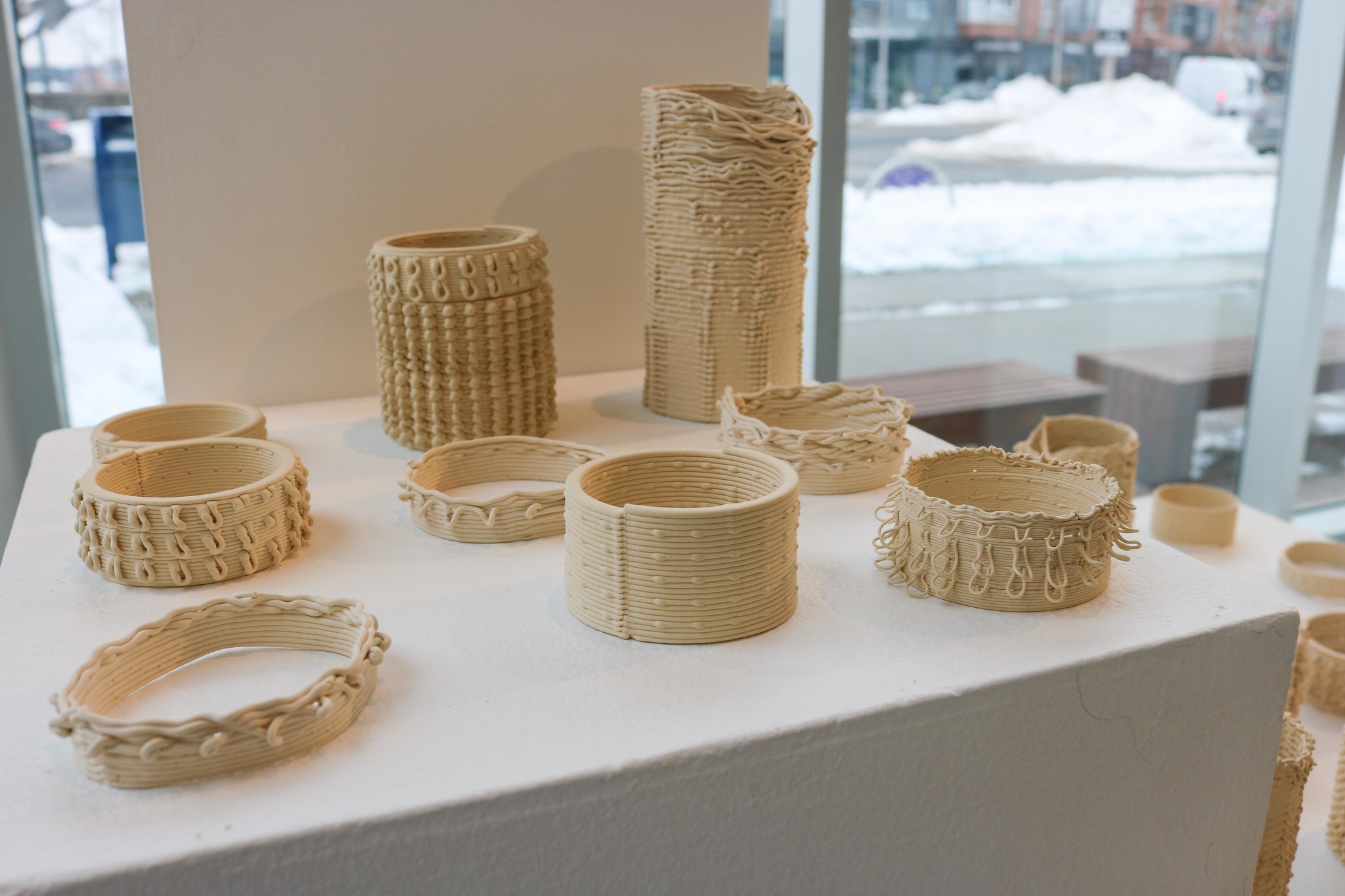

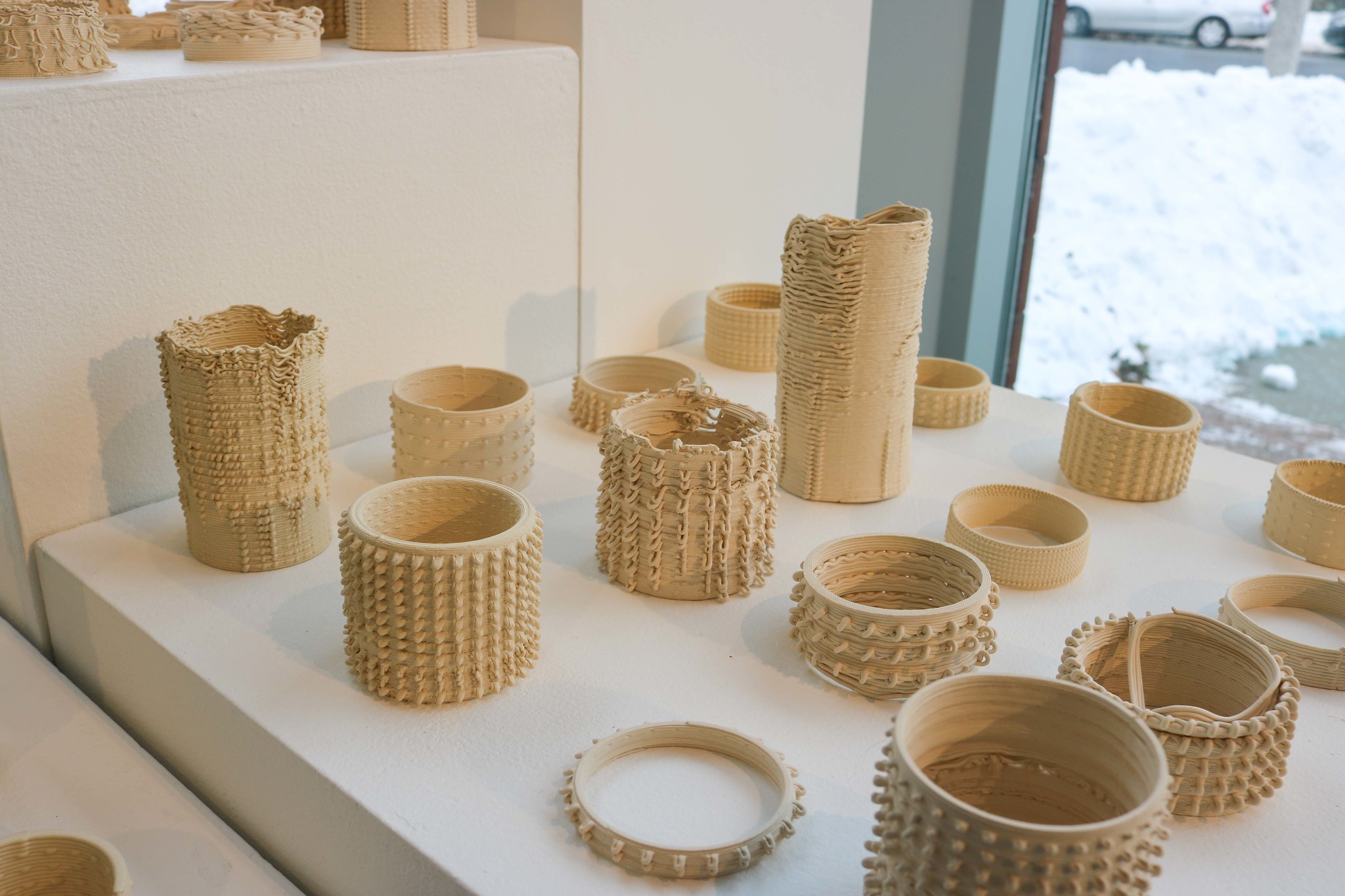

The textures and pattens achieved during the additive clay extrusion process are outcomes of toolpath code manipulation as much as they are dependent on machine parameters, such as machine speed, extrusion flow rate, and layer height. There is a growing interest in the customization and manipulation of clay deposition toolpaths which impart new expressions of patterns, textures, and features within the clay artifact which otherwise cannot be accurately represented or predicted within the surface typology of 3D models. Textures within 3D clay printed objects which resemble woven or knitted patterns are typically a result of isolating toolpath layers and affecting a binary pattern across the individual waypoints belonging the toolpath of each print layer. This toolpath manipulation is a post-processing technique which is able to be applied to any 3D model that is suitable for additive clay deposition processes.




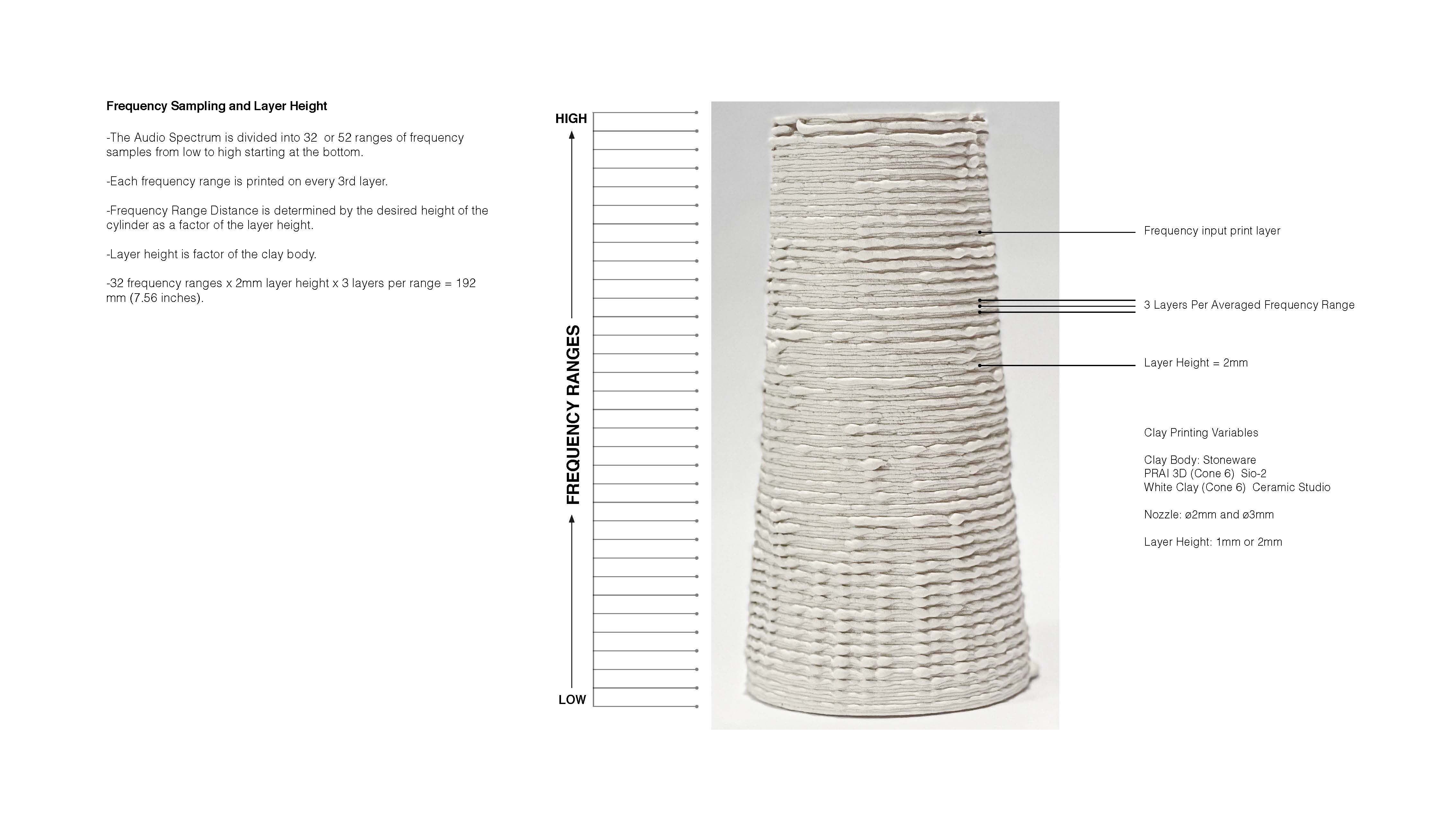
In the book, Advanced 3D Printing with Grasshopper: Clay and FDM, authors D. Diego Garcia Cuevas and D. Gianluca Pugliese outline three primary techniques in the potential of using soft forms of data within the Rhino and Grasshopper environment as the generative agents of toolpath augmentation. The first technique uses 0 and 1 binary patterns to impart articulated weaving pattens within the toolpath. The second technique that Cuevas and Pugliese demonstrate is the use of attractor geometries, (points and curves), to shift toolpath waypoints. The third technique uses gray scale image processing to move points according to grayscale values. In each of these techniques, the toolpath waypoints are shifted in a normal direction to the surface of the model that will be printed by using external data, whether that be a binary sequence pattern, reference geometry not belonging to model itself, or a referenced image. These techniques point to the possibilities of using externally derived sources of data as the active agent for generating toolpaths.
Research
Our research was broken out into three primary phases. The first phase was to test and create a library of toolpath patterns in order to demonstrate control and repeatability of desired toolpath patterns within our clay artifacts. The second phase was the development of a digital workflow. The digital workflow was developed in parallel to the creation of the toolpath pattern library. The third phase was the testing and implementation of the frequency data to generate toolpaths.
- Machine :A WASP Delta 2040 Clay printer was used with a 2 mm Nozzle
- Fixed Parameters: Feed Rate = 1800 mm/second, Extrusion Flow factor = 2 (1mm extrusion length /1mm travel), Layer Thickness = 1mm
- Clay Bodies: PRAI 3D Stoneware for 3D Printing
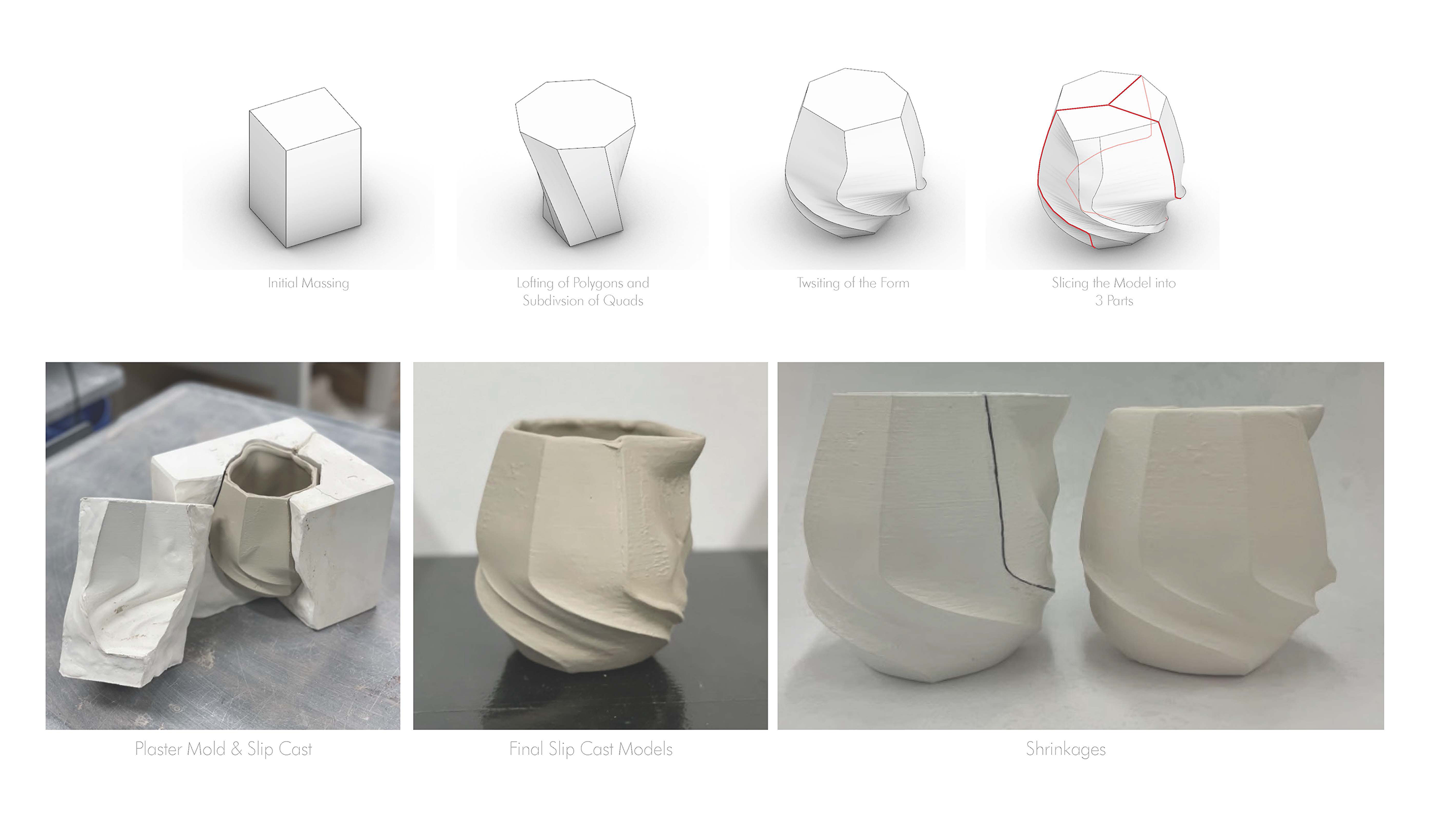
Developing a Taxonomy
Our first step was to establish a library of toolpath patterns to be used in the clay printing. Referencing W, Andrew Atwood's work outlined in 'Monolithic Representations' we chose three toolpath patterns to establish a taxonomy of Pause, Weave, and Loop. (Figure 4). We started by establishing our values for the baseline variables of feed rate, extrusion flow rate, and print layer thickness. These variables are largely dependent on the clay body used. Once the desired result had been achieved in a simple baseline print of a test cylinder, these variables became fixed values used to develop and catalog the Pause, Weave, and Loop patterns.
The Pause pattern is achieved by pausing the machine movement for a set length of time while extruder continues to deposit clay. The result is a uniform ball like feature. The Weave pattern is achieved by moving toolpath waypoints in a perpendicular direction outward from the surface of the artifact. The result is similar to the Pause pattern but displays more variance in the pattern from the motion of the machine. The Loop pattern is similar to the Weave patten with the exception of including more points within the movement away from the surface. For each pattern, incremental magnitudes of movement were tested and a maximum distance of movement for each pattern was determined. Each pattern was then assigned a range of movement to be used for remapping frequency values. From this testing, it was determined that each manipulated toolpath layer would happen every 3 layers in order to great enough vertical space between large pattern articulations.
Digital Workflow
The digital workflow was developed using two different software environments. TouchDesigner, a visual and audio development platform, was used for all the audio
processing. Rhino and Grasshopper were used to generate the toolpaths.
Audio Processing
In TouchDesigner, frequencies from 20Hz to 20,000Hz are isolated from the audio frequency spectrum and are grouped and averaged together. The number of the frequency bands is determined by the grouping size. Each frequency band corresponds to a toolpath layer and is a determinate factor in the overall layer height of printed artifact. The number of frequency bands x layer height x number of layers per frequency band determines the height of the printed artifact. Sampling was tested at 2 samples per second and 4 samples per second. The frequency bands were then recorded over a specified duration of time at a fixed sample per second and exported as a CSV file.
![]()
![]()
![]()
![]()
![]()
![]()
![]()
![]()
![]()
![]()
Our first step was to establish a library of toolpath patterns to be used in the clay printing. Referencing W, Andrew Atwood's work outlined in 'Monolithic Representations' we chose three toolpath patterns to establish a taxonomy of Pause, Weave, and Loop. (Figure 4). We started by establishing our values for the baseline variables of feed rate, extrusion flow rate, and print layer thickness. These variables are largely dependent on the clay body used. Once the desired result had been achieved in a simple baseline print of a test cylinder, these variables became fixed values used to develop and catalog the Pause, Weave, and Loop patterns.
The Pause pattern is achieved by pausing the machine movement for a set length of time while extruder continues to deposit clay. The result is a uniform ball like feature. The Weave pattern is achieved by moving toolpath waypoints in a perpendicular direction outward from the surface of the artifact. The result is similar to the Pause pattern but displays more variance in the pattern from the motion of the machine. The Loop pattern is similar to the Weave patten with the exception of including more points within the movement away from the surface. For each pattern, incremental magnitudes of movement were tested and a maximum distance of movement for each pattern was determined. Each pattern was then assigned a range of movement to be used for remapping frequency values. From this testing, it was determined that each manipulated toolpath layer would happen every 3 layers in order to great enough vertical space between large pattern articulations.
Digital Workflow
The digital workflow was developed using two different software environments. TouchDesigner, a visual and audio development platform, was used for all the audio
processing. Rhino and Grasshopper were used to generate the toolpaths.
Audio Processing
In TouchDesigner, frequencies from 20Hz to 20,000Hz are isolated from the audio frequency spectrum and are grouped and averaged together. The number of the frequency bands is determined by the grouping size. Each frequency band corresponds to a toolpath layer and is a determinate factor in the overall layer height of printed artifact. The number of frequency bands x layer height x number of layers per frequency band determines the height of the printed artifact. Sampling was tested at 2 samples per second and 4 samples per second. The frequency bands were then recorded over a specified duration of time at a fixed sample per second and exported as a CSV file.





